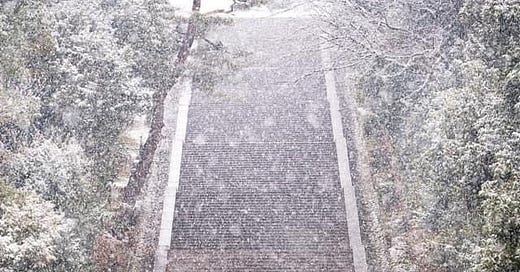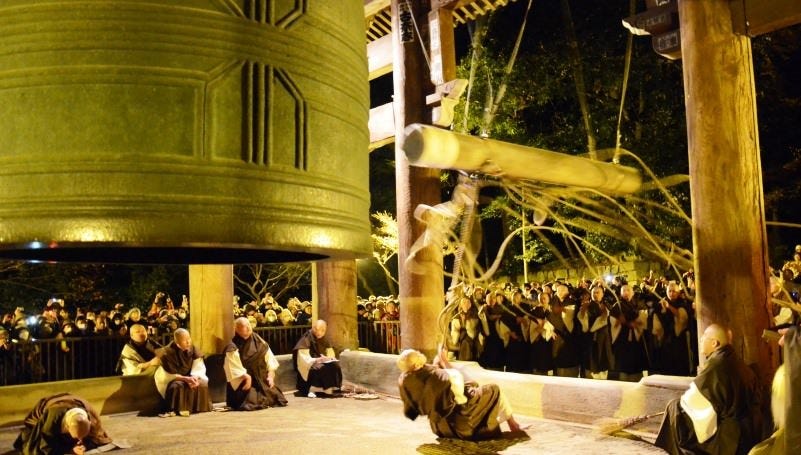We were eating not far from the temple in Kyoto as they began the joya-no-kane bell ringing on New Year’s Eve. It seemed to go on forever. We were having sashimi before eating toshikoshi-soba noodles, which is traditionally eaten close to midnight on New Year’s Eve. I was startled when the sashimi started wriggling at the end of my chopsticks… Tetsuya was delighted at how “fresh” it was ~~but I lost my appetite!
What I remember is the sound of the bell. As I get older, I am finding that sounds trigger my memories much more than fragrances or visions. A friend on Facebook posted this gorgeous photograph of the steps leading up to Chion-in Temple and immediately it triggered a vivid memory of the sound of the bell, which is struck 108 times on New Year’s Eve. The number 108 represents the number of earthly desires that afflict and pain the human heart. With each ring of the bell, it is said, people are purified.
I just finished a little jewel of a book called Sonorous Desert: What Deep Listening Taught Early Christian Monks—and What It Can Teach Us, by Cornell University professor of early Christianity and early Judaism Kim Haines-Eitzen.
Haines-Eitzen writes of the way sound is one of the primary ways we have of experiencing and situating ourself in “place.” We find home in attuning ourselves to the sounds of that place. Even now the watery sound of crickets chirping in the wet lawn in early autumn nights transports me back to my childhood, as does the sound of swarming, buzzing bees. It brings me straight back to my childhood in suburban Los Angeles.
Japan is the ringing of the railroad crossing bell heard when the world is hushed by snow or the high-pitched voice of the elevator girl in a department store. Like the bells of Chion-in Temple, the trilling of a bamboo flute transports me straight back to summer festivals and fireflies in Tochigi. And the recorded announcements as the trains roll into the stations immediately bring me back to Tokyo.
It is a revelation of memories. I am even finding that I dream more in sound these days.
The epigram of Haines-Eitzen’s book is a quote from composer John Luther Adams’ book The Place Where You Go to Listen:
Listening is a primary mode of understanding. As we listen to the world around us, we come to understand more deeply our place within it. Our listening animates the world. And the world listens back.
I am interested in this kind of active and attentive listening since being embedded in a "soundscape" demands a certain two-way, give-and-take hearing. This attunement of oneself to the local environment/community and to place (terroir) situates a person in that place. That is because when you stop and listen, you thereby come to belong to the land as much as the land belongs to you–even if just in that moment. The world is no longer a resource to be efficiently consumed but instead becomes lit up and embodied with voice and with sentiment—or as Adams says, our listening animates the world.
除夜の鐘 Beautiful video of the bell ringing makes me cry






Main thing here for me is how effortlessly you dispense of the idea that the world is "a resource to be efficiently consumed." Clear. Obvious. Thanks for showing that's so.
I haven't been to Japan in many years, but it's always the sound of the train crossing and the clack-clack of the trains on the tracks that brings me back. Also, I've been "trained" by many years of watching Japanese dramas to pay attention to the bird and insect sounds to tell me what time of year it is! It's funny, I've obviously never really heard those birds and insects, except maybe for cicadas since I've only visited Japan in summer.